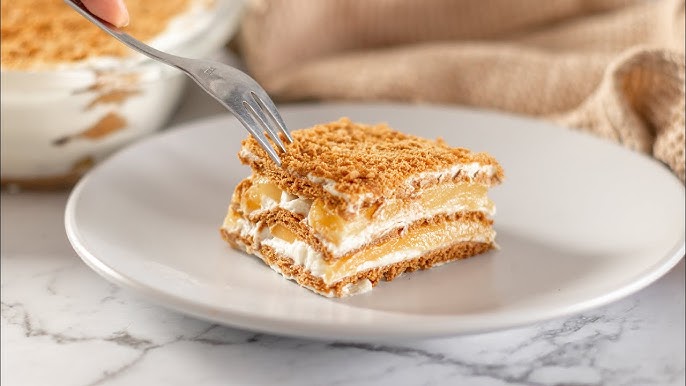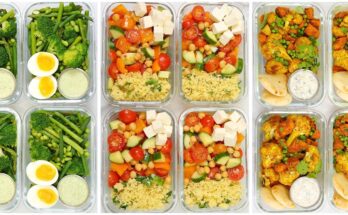Mango Float Recipe: If you’re craving something sweet, creamy, and refreshing, mango float is one dessert that never fails to impress. This no-bake Filipino dessert has become a favorite not just in the Philippines but also around the world. It’s light, fruity, and simple to make, yet looks as elegant as any cake you’d find in a bakery. Whether you’re preparing for a party, a family gathering, or simply want to treat yourself, this step-by-step guide will show you exactly how to make the perfect mango float at home.
What is Mango Float?
Mango float, also known as “Mango Graham Cake,” is a no-bake layered dessert made with ripe mango slices, whipped cream, condensed milk, and graham crackers. The combination of sweet mangoes and rich cream, balanced by the crunch and softness of graham crackers, creates a melt-in-your-mouth experience. Unlike traditional baked desserts, this one requires no oven, which makes it an instant favorite for people who want something quick and easy to prepare.
Think of mango float as the tropical cousin of tiramisu or an icebox cake. It has layers upon layers of flavor, and the best part is—it tastes even better after chilling overnight. The cream and crackers meld together beautifully, absorbing the mango’s sweetness, giving you a creamy yet fruity dessert that feels indulgent but refreshing at the same time.
Why Mango Float is Loved Worldwide
There are plenty of reasons why mango float has captured hearts beyond the Philippines. First, it’s effortless. Even if you’ve never cooked before, you can master this dessert without stress. Second, it’s versatile—you can serve it as a cake, cut into squares, or scoop it like a trifle. Third, the flavor of ripe mangoes is universally adored. When combined with cream and graham crackers, it becomes a dessert that transcends cultures.
It’s also affordable. The ingredients are simple and widely available. You don’t need expensive baking tools or professional skills. With just a bowl, spatula, and a refrigerator, you can whip up a dessert that rivals gourmet cakes. And let’s be honest—when you present mango float at a party, it always steals the spotlight.
Ingredients You’ll Need
Main Ingredients for Mango Float
Here’s everything you’ll need to prepare a classic mango float:
- Ripe Mangoes – The star of the dish. Sweet, golden mangoes are ideal for this recipe. Carabao mangoes (Philippine mangoes) are preferred, but any ripe, juicy mango will work.
- Graham Crackers – Used as the base and layers of the dessert. They soak up the cream and mango juice, creating a soft cake-like texture.
- All-Purpose Cream (or Heavy Cream) – Whipped to create a fluffy, creamy layer.
- Sweetened Condensed Milk – Mixed with the cream to add sweetness and richness.
These four ingredients are the backbone of mango float. However, you can always add your own twist with toppings like crushed graham, chocolate shavings, or even nuts for extra crunch.
Substitutes You Can Try
Can’t find graham crackers? No worries. You can use:
- Digestive biscuits
- Ladyfingers (for a tiramisu-like twist)
- Butter cookies or vanilla wafers
For the cream, if all-purpose cream isn’t available, whipping cream or double cream works just fine. And if you prefer less sweetness, you can reduce the condensed milk or use a bit of powdered sugar instead.
For mango substitutes (in case they’re not in season), peaches, strawberries, or canned fruit cocktail can give you a fruity alternative. Of course, nothing beats the real sweetness of fresh mangoes, but it’s nice to know you have options.
Tools and Equipment Needed
Mango float doesn’t demand fancy kitchen gadgets, but here’s a quick checklist:
- Mixing bowl (for the cream mixture)
- Hand mixer or whisk
- Glass dish or baking pan (transparent containers make the dessert look more appealing)
- Spatula for spreading
- Knife and chopping board for slicing mangoes
- Plastic wrap or foil (for covering before chilling)
That’s it! With these tools and ingredients ready, you’re all set to create your mango float masterpiece.
Preparing for Mango Float
Selecting the Best Mangoes
The secret to a heavenly mango float lies in the quality of the mangoes. Always go for ripe, sweet mangoes. In the Philippines, Carabao mangoes are prized for their sweetness and fragrance, making them the top choice. If you’re outside the Philippines, look for Ataulfo mangoes or Alphonso mangoes, which also have a rich flavor.
When buying mangoes, check for:
- Color: Golden yellow indicates ripeness.
- Texture: Slightly soft but not mushy.
- Aroma: A sweet fragrance near the stem means it’s perfectly ripe.
Avoid unripe mangoes since they can turn sour and ruin the dessert. Overripe ones, on the other hand, may turn mushy and watery, making the float soggy.
Prepping the Graham Crackers and Cream
Before assembling, make sure your graham crackers are whole and not crushed (except for the topping). You want neat layers for a visually pleasing result.
For the cream, chill it in the refrigerator for at least an hour before whipping. Cold cream whips better and holds its structure longer. If you’re using a hand mixer, whip until soft peaks form. Then, fold in the condensed milk gently. This creates a sweet, fluffy cream base that’s easy to spread.
Chilling Ingredients for Best Results
One common mistake people make is skipping the chilling process. Chilling is crucial for mango float because:
- It helps the cream set and thicken.
- It allows the crackers to absorb moisture and soften.
- It enhances the overall flavor as the layers meld together.
Ideally, refrigerate your prepared mango float for at least 6 hours, but overnight is best. Some people even freeze it for a few hours before serving, giving it an ice cream cake-like texture.
Step-by-Step Guide to Making Mango Float
Step 1 – Preparing the Mangoes
Wash and peel the mangoes carefully. Slice off the cheeks (the fleshy sides) and cut them into thin strips or cubes. Thin slices are usually preferred because they create elegant layers. Place them in a bowl and set aside.
Step 2 – Making the Cream Mixture
In a chilled mixing bowl, pour in the all-purpose cream. Whip it until it becomes fluffy. Slowly add condensed milk while continuing to whip until the mixture is smooth and creamy. Taste it—you can adjust the sweetness by adding more or less condensed milk.
Step 3 – Layering the Dessert
Now comes the fun part. Take a clean glass dish and start with a layer of graham crackers at the bottom. Spread a generous amount of cream mixture evenly. Add a layer of mango slices on top. Repeat this process—graham, cream, mango—until you fill the dish. Make sure the top layer ends with cream and mango slices for a beautiful presentation.
Step 4 – Adding Final Touches
Crush a few graham crackers and sprinkle them over the top layer for added texture. You can also drizzle chocolate syrup, caramel, or add roasted nuts if you want to get creative.
Step 5 – Chilling Before Serving
Cover the dish with plastic wrap or foil and refrigerate it for at least 6 hours, ideally overnight. This waiting time is worth it because it allows all the flavors to blend perfectly. Once chilled, slice into squares or scoop into bowls and serve cold.
Tips and Tricks for Perfect Mango Float
How to Make Mango Float Creamier
If you’ve ever wondered why some mango floats taste extra smooth and creamy, the secret lies in the cream mixture. While all-purpose cream and condensed milk work wonderfully, you can upgrade it by folding in whipped heavy cream for an airy, mousse-like texture. Another trick is to chill your mixing bowl and beaters before whipping. This keeps the cream cold and stable, making it easier to whip to soft peaks.
If you like your dessert extra indulgent, add a splash of vanilla extract or even a spoonful of cream cheese into the cream mixture. Cream cheese adds a subtle tanginess that balances the sweetness, giving your mango float more depth of flavor. Another option is adding powdered sugar instead of condensed milk if you prefer a lighter version. The key is balance—too much sweetness can overpower the mango’s natural flavor, while too little can make it taste bland.
A final touch to boost creaminess is letting your mango float rest overnight in the fridge. The longer it chills, the creamier it gets as the crackers fully absorb the cream. This not only softens the layers but also creates that melt-in-your-mouth experience that mango float is famous for.
Avoiding Common Mistakes
Even though mango float is simple to make, beginners often make small mistakes that affect the final result. Here are the most common pitfalls and how to avoid them:
- Using unripe mangoes – Sour mangoes can completely throw off the flavor. Always taste your mango before layering.
- Watery cream – If your cream isn’t whipped enough or isn’t chilled properly, it can make the dessert soggy.
- Too much condensed milk – Overly sweet cream can mask the natural fruitiness of the mango. Start with less and adjust.
- Not chilling long enough – Mango float needs at least 6 hours in the fridge, but overnight is ideal. Skipping this step leaves you with hard crackers that don’t blend well.
- Uneven layers – Thick mango slices or uneven spreading can make the dessert lopsided. Aim for neat, even layers for the best texture and presentation.
Avoiding these mistakes guarantees a smooth, creamy, and perfectly balanced mango float every single time.
How to Store Mango Float Properly
One of the great things about mango float is that it keeps well in the fridge. After preparing, store it covered with plastic wrap or foil to prevent it from absorbing fridge odors. It can last up to 4–5 days when refrigerated, though it’s usually eaten long before that!
If you’d like to store it longer, mango float can also be frozen. Freezing turns it into a refreshing ice cream cake-like dessert. When serving from the freezer, let it sit at room temperature for about 10 minutes before slicing so it softens slightly.
If you have leftovers, keep them in an airtight container. Just remember that while freezing is fine, refreezing after thawing isn’t recommended because it can affect the texture of the cream.
Different Variations of Mango Float
Classic vs. Modern Versions
The classic version of mango float is made with just four main ingredients—mango, cream, condensed milk, and graham crackers. But over the years, creative cooks have developed different variations to suit their taste and add a little twist.
Modern versions often include toppings like chocolate shavings, caramel drizzle, or crushed Oreos. Some even replace graham crackers with ladyfingers, sponge cake, or digestive biscuits. If you want a healthier take, you can use yogurt instead of cream and add layers of granola for crunch.
Each version has its charm. The classic is light and refreshing, while the modern twists are rich and indulgent, almost like a fusion of cheesecake and trifle.
Mango Float with Chocolate
Chocolate lovers often add a layer of chocolate ganache or sprinkle cocoa powder in between layers. The bitterness of chocolate balances the sweetness of mango, making it a perfect combination for those who prefer less sugary desserts.
Mango Float with Nuts
Adding roasted cashews, almonds, or pistachios gives the dessert a delightful crunch. Nuts also add a nutty, earthy undertone that complements the creaminess of the dessert.
Frozen Mango Float
If you want something closer to an ice cream cake, simply freeze the mango float instead of refrigerating it. When frozen, the cream hardens slightly, and the dessert takes on a refreshing ice cream-like consistency. It’s especially popular during summer when everyone’s craving something cold.
Serving Suggestions for Mango Float
Perfect Occasions to Serve Mango Float
Mango float is versatile and fits into almost any occasion. It’s perfect for:
- Family gatherings
- Birthday parties
- Summer picnics
- Holiday feasts (especially Christmas and New Year in the Philippines)
It’s also a popular potluck dish because it’s easy to make in large quantities. Since it doesn’t require baking, you can whip it up in just 30 minutes, let it chill, and have it ready for your event.
How to Plate Mango Float Elegantly
If you want to impress your guests, presentation matters. Here are some ideas:
- Serve in clear glass containers to showcase the beautiful mango layers.
- Cut into neat squares and plate with a drizzle of caramel or chocolate sauce.
- Use individual dessert cups for portion control and easy serving.
- Garnish with fresh mint leaves or extra mango slices for a fresh finish.
For more formal settings, layering mango float in wine glasses or parfait cups makes it look like a gourmet dessert. It’s the same recipe, just presented in a fancier way.
Nutritional Value of Mango Float
Calories and Nutritional Breakdown
Like most desserts, mango float is indulgent, but it does offer some nutritional value thanks to the mangoes. Here’s a rough breakdown for one serving (depending on portion size and ingredients):
- Calories: 250–350 kcal
- Carbohydrates: 35–45 g
- Protein: 3–5 g
- Fat: 12–18 g
- Fiber: 2–3 g
Mangoes are rich in Vitamin C, Vitamin A, and antioxidants. They add a fruity sweetness without the need for too much added sugar. However, the cream and condensed milk do make this a calorie-dense dessert, so moderation is key.
Healthier Alternatives
If you want to enjoy mango float guilt-free, here are some tips:
- Replace condensed milk with honey or stevia for natural sweetness.
- Use Greek yogurt or low-fat cream instead of heavy cream.
- Swap graham crackers for oatmeal cookies or digestive biscuits for added fiber.
- Add chia seeds or flaxseeds in between layers for a healthy boost.
By tweaking the ingredients, you can make mango float lighter without sacrificing flavor.
Mango Float Around the World
Filipino Pride
In the Philippines, mango float is considered a household dessert. It’s easy, affordable, and showcases the country’s national fruit—the mango. Families often prepare it during fiestas, Christmas, and other celebrations.
International Popularity
Thanks to social media and food blogs, mango float has gained international recognition. Many people outside the Philippines now make it as a no-bake summer dessert. In some countries, it’s referred to as “mango icebox cake.”
Similar Desserts in Other Cultures
- In the U.S., it resembles the icebox cake made with graham crackers and whipped cream.
- In Italy, it’s somewhat like tiramisu, except mango float uses fruit instead of coffee and mascarpone.
- In India, mango float resembles mango mousse cake, though that version often involves gelatin.
This just proves how universally loved the combination of fruit, cream, and biscuits really is.
Creative Ideas to Elevate Mango Float
Individual Mango Float Cups
Instead of making one big tray, you can prepare mango float in small dessert cups or jars. This makes serving easier and looks more elegant, especially for parties. Each guest gets their own portion, and you don’t have to worry about messy slicing.
Layer with Jelly or Gelatin
Adding a thin layer of mango-flavored jelly or gelatin between the cream and cracker layers can make the dessert more playful and colorful. It also adds a firmer texture that contrasts with the creaminess.
Mango Float Cheesecake Fusion
For a decadent twist, combine mango float with cheesecake. Add a cream cheese mixture into the cream layer and top with mango puree. The tangy cheesecake flavor balances beautifully with the sweetness of the mango.
Frozen Mango Float Pops
Want something fun and refreshing for kids? Prepare mango float in popsicle molds. Layer crushed graham, cream, and mango slices inside the mold, then freeze. You’ll end up with frozen mango float pops—perfect for hot summer days.
Why Mango Float is the Perfect No-Bake Dessert
Quick and Easy to Prepare
One of the best things about mango float is how simple it is. You don’t need an oven, mixer, or special cooking skills. In just 20–30 minutes, you can assemble the dessert, then let the fridge do the rest. This makes it perfect for beginners or anyone short on time.
Budget-Friendly Ingredients
All the ingredients are affordable and widely available. Mangoes, cream, and graham crackers don’t cost much, making mango float a practical dessert option for big gatherings. Compared to baked cakes or fancy desserts, it’s a cost-effective yet impressive dish.
Customizable for Every Taste
Whether you prefer it sweeter, lighter, fruitier, or richer, mango float is flexible. You can adjust the cream, change the fruit, add toppings, or even make it vegan. That adaptability is what makes mango float stand out—it can please almost any palate.
Step-by-Step Summary of Mango Float Recipe
Here’s a quick recap of the recipe in case you want the simplified version:
Ingredients:
- 3–4 ripe mangoes (sliced thinly)
- 2 packs graham crackers
- 2 cups all-purpose cream (chilled)
- 1 can condensed milk
- Crushed graham for topping
Instructions:
- Chill the cream for at least an hour before whipping.
- In a bowl, whip cream until fluffy, then add condensed milk. Mix until smooth.
- Slice mangoes into thin strips or cubes.
- In a glass dish, layer graham crackers at the bottom.
- Spread cream mixture evenly over the crackers.
- Add a layer of mango slices.
- Repeat layers until dish is full, ending with cream and mango on top.
- Sprinkle crushed graham on top.
- Cover and refrigerate for at least 6 hours, preferably overnight.
- Slice and serve chilled.
And there you have it—your very own mango float!
FAQs about Mango Float Recipe
1. Can I make mango float without graham crackers?
Yes! You can substitute them with digestive biscuits, vanilla wafers, ladyfingers, or even thin slices of sponge cake.
2. How do I keep mango float from becoming soggy?
Make sure to chill the cream before using and avoid over-layering with too much cream. Chilling overnight helps the layers set properly without getting soggy.
3. What’s the difference between mango float and mango graham cake?
They are the same dessert. Some people call it “mango graham cake” because of the use of graham crackers, while others call it “mango float.”
4. Can I make a sugar-free mango float?
Yes, you can use sugar-free condensed milk or replace condensed milk with stevia or honey for a healthier alternative.
5. What’s the best way to serve mango float for parties?
Prepare it in a large glass dish for slicing or serve in individual cups for a cleaner, more elegant presentation.
Conclusion
Mango float is more than just a dessert—it’s comfort food, a party favorite, and a piece of Filipino culinary pride. With just a few ingredients and no baking required, anyone can whip up this creamy, fruity treat. The layers of graham crackers, cream, and sweet mangoes create a harmony of textures and flavors that keep people coming back for more.
Whether you stick with the classic recipe or experiment with variations like chocolate, nuts, or cheesecake fusion, mango float is guaranteed to impress. It’s affordable, quick to make, and can easily be customized for different diets or preferences. Most importantly, it’s one of those desserts that bring people together—perfect for sharing at family gatherings, holidays, or even just a cozy weekend at home.
So, the next time you’re craving something sweet and refreshing, give mango float a try. Once you taste it, you’ll understand why it has become a beloved dessert not only in the Philippines but around the world.



